Bordering on Georgia and South Carolina, Lake Hartwell is one of the most popular recreational lakes in the American Southeast. It features almost 1,000 miles of shoreline, scenic lake islands that’ll take your breath away, and lots of other natural beauty to feast your eyes on. But among all the activities you can enjoy out here, it’s really the fishing in Lake Hartwell that these waters are famous for.

The lake is impounded by the Hartwell Dam on the Savannah River. But since the dam lies below the point at which Seneca and Tugaloo rivers merge into the Savannah, Lake Hartwell actually encompasses portions of all three of these rivers. Because of this, it boasts a vibrant and diverse ecosystem, giving fish a fantastic habitat to thrive in.
If you haven’t had the chance to fish the lake yet, follow along and we’ll try to present it in its full glory. You’ll get to read about the species you can catch in these waters and a few ways to do so. We’ll also cover some of the fishing spots in Lake Hartwell so you have an idea of where to go. Are you ready to dive in?
What kind of fish can you catch in Lake Hartwell?
| Species | Jan | Feb | Mar | Apr | May | Jun | Jul | Aug | Sep | Oct | Nov | Dec |
|---|---|---|---|---|---|---|---|---|---|---|---|---|
| Largemouth Bass | Weak | Weak | Good | Great | Great | Great | Good | Good | Great | Great | Good | Weak |
| Spotted Bass | Weak | Weak | Good | Great | Great | Great | Good | Good | Great | Great | Good | Weak |
| Striped Bass | Weak | Weak | Good | Great | Great | Great | Great | Great | Great | Great | Good | Weak |
| Hybrid Striped Bass | Weak | Weak | Good | Great | Great | Great | Great | Great | Great | Great | Good | Weak |
| Catfish | Weak | Good | Good | Great | Great | Great | Great | Great | Great | Great | Good | Weak |
On Lake Hartwell, it’s all about that Bass. Well, mostly anyway. There are several types of these hardy fish lurking in the lake, in addition to some other species prowling about. Have a look at what you’ll be targeting.
Black Bass
Three Black Bass species inhabit Lake Hartwell. They include Spotted and Largemouth Bass, as well as Bartram’s Redeye, which have mostly been outcompeted by the former two. When it comes to Spotted and Largemouth Bass, both bear similar markings and grow to similar sizes, though the latter can get bigger. So how do you tell the difference? Usually, by the size of their mouths, the trait Largemouth Bass got their name for.
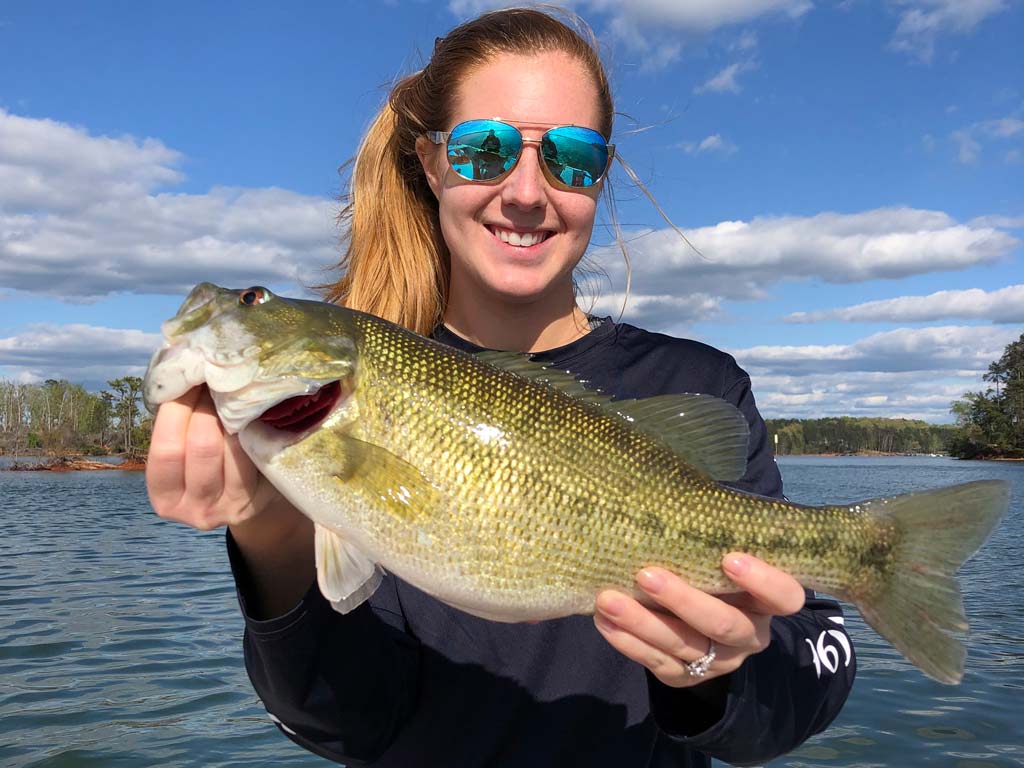
While Largemouth Bass might be more famous, many Bass anglers will tell you it’s actually Spotties that fight harder. When you hook them, they’ll present you with a ferocious fight, diving deep to try to shake you off. Compared to Largemouth, Spotted Bass also fight longer, putting up a struggle all the way until you bring them in.
With numerous creeks, coves, and river arms, as well as complex bottom terrain, Lake Hartwell is a Bass fishing heaven. A testament to this is the fact that the famed Bassmaster tournament has taken place on the lake several times. Since Lake Hartwell is so diverse, the Bass patterns are not always easy to figure out. However, you’re more likely to find them up in creek arms and around shallow cover in spring and fall, and in the main lake during summer.
Striped and Hybrid Bass
Stripers and Hybrids, or Wipers as they call them, are also Bass, but since they belong to different families compared to our previous entry, we’ll list them separately. In Lake Hartwell, you’ll find healthy populations of both of these fish. In fact, they’re probably the most popular targets among non-tournament anglers.
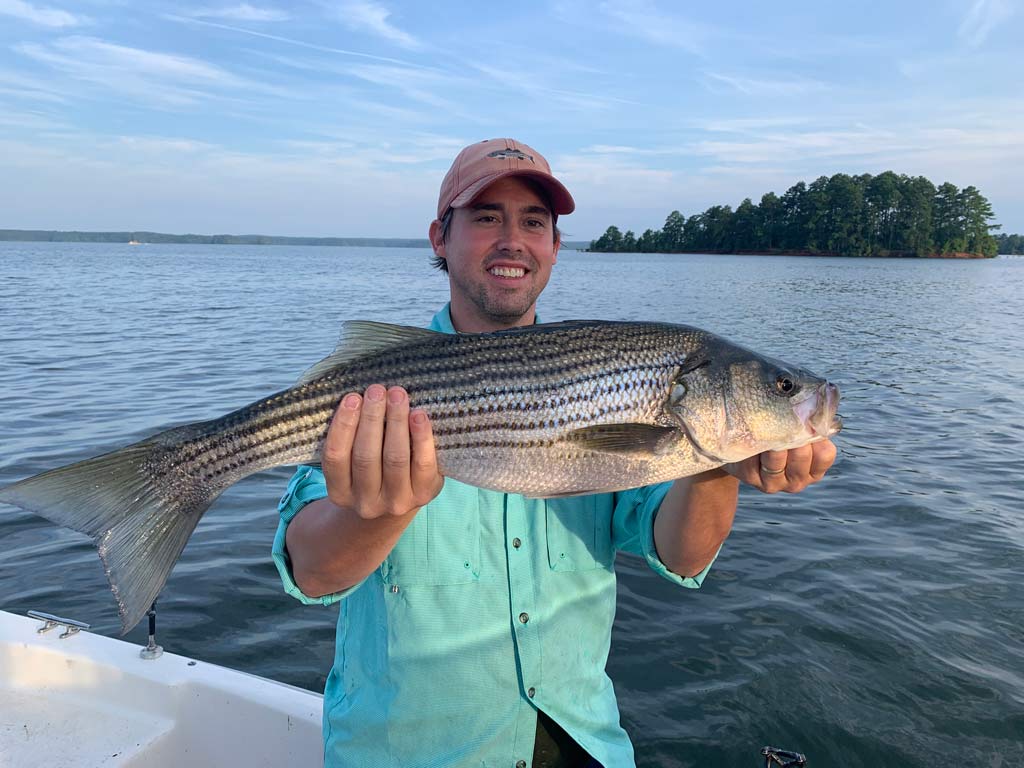
Between the two, Striped Bass grow much bigger, and it’s usually the prospect of catching a big one that entices so many anglers to go after these fish. However, pound-for-pound, Hybrid Striped Bass will grace you with a more thrilling fight. They inherit their fighting ferocity from one of their parent species, White Bass. Conversely, the fact that they’re larger than White Bass is owed to their Striper origins.
Either way, while Hybrids fight harder, Stripers are still capable of putting on a show when you hook them. So no matter which one you end up trying to reel in, you’re in for a fun time.
On Lake Hartwell, you can catch both of these fish for most of the year. Usually, the fishing starts in the Tugaloo and Seneca River arms in spring and remains strong over summer, when fish move deep into the lake. You’ll even get to catch them in the fall, all the way until the waters get really cold.
Catfish
The lake’s nooks and crannies are also home to three types of Catfish – Flathead, Blue, and Channel. Blue Catfish grow the biggest of the three, followed by Flathead. Channel Catfish are smaller than both but found in greater numbers than their cousins.
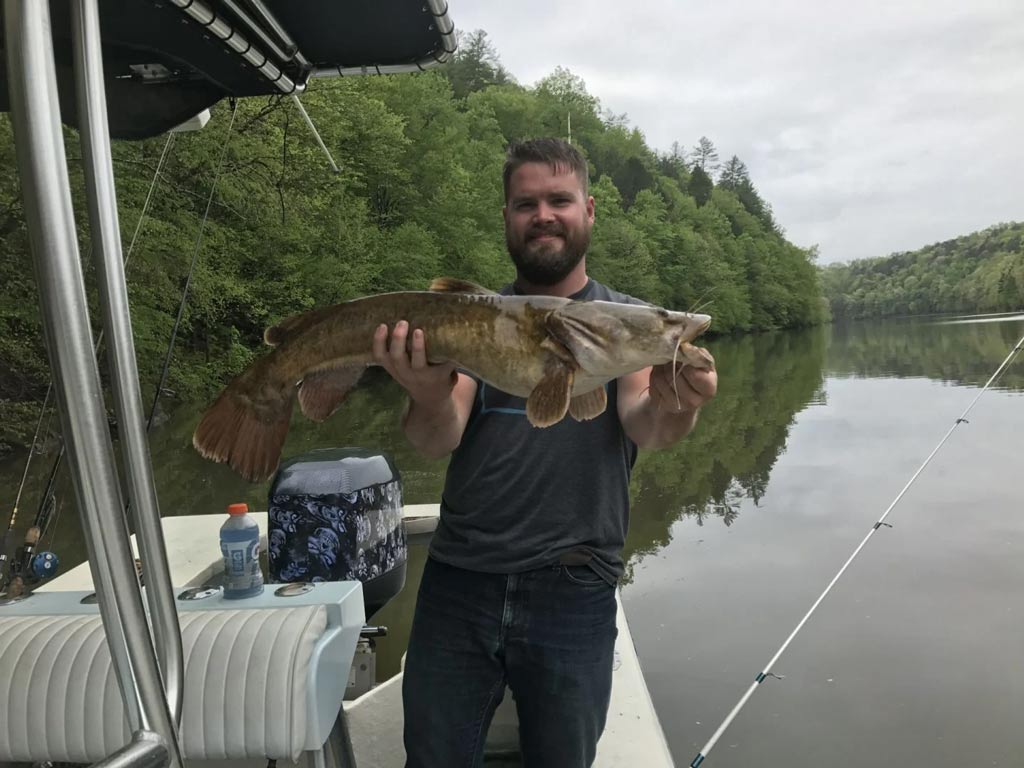
If you haven’t had the opportunity to wrestle mustached creatures yet, you should know that they’re some of the best freshwater fighters you can run across. As soon as they reach about 15 pounds in weight, they’ll be able to pull hard and present an exciting challenge. Now, consider that Blue and Flathead Catfish can reach weights upwards of 100 pounds. Can you imagine what it’d be like to wrestle a river monster like that?
So if you’d like to give your muscles a workout, the Catfish action starts in late winter on Lake Hartwell. Early in the season, they’ll dwell in deep waters, at depths of 60 to 80 feet. As the waters warm up, they’ll move to more shallow regions of the lake. Eventually, you’ll find them in creeks, coves, and similar hiding holes. They’re scent hunters so bring bait that they’ll be able to sniff out. Some popular ones include stinkbait, cut herring, bream, or gizzard shad.
And More!
Lake Hartwell consists of 56,000 acres of water. Considering that, the species we named so far are not the only ones you’ll find swimming about. For example, whenever you’re in the mood for some panfish, you can go for White and Black Crappie, as well as Sunfish lurking in the lake.
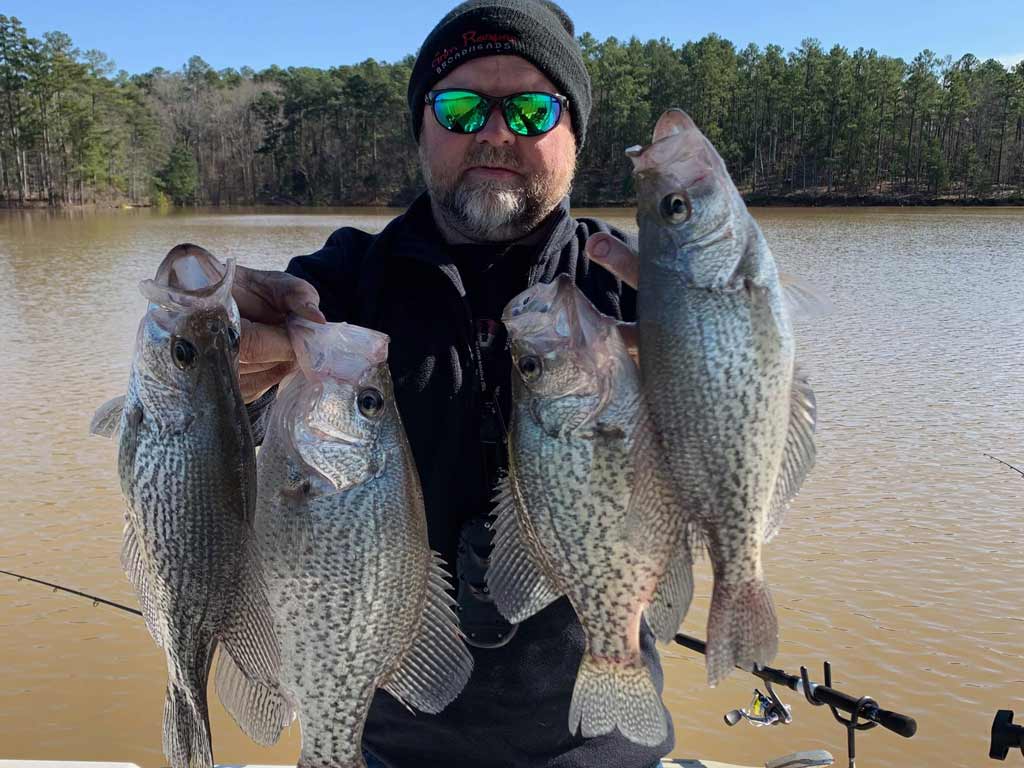
Lake Hartwell is also one of the only two lakes in South Carolina, the other one being Lake Russell, where you can find Walleye. If you’re keen on catching some of these delicious fish, visit during springtime. That’s when they’ll be on the move, migrating from deep to shallow waters.
Occasionally, you’ll even get the opportunity to catch Rainbow Trout in these waters. They’re not exactly one of the main targets, but you can catch them if you fish below the lake’s dam. So, as you can likely tell by now, Lake Hartwell is incredibly diverse. It’ll offer you plenty of variety no matter when you decide to fish it.
How to Go Fishing in Lake Hartwell
When it comes to fishing in Lake Hartwell, there are a few different ways to experience it. This all depends on your preferences, experience, budget, and how much time you have, but each approach offers something unique. So let’s go over a few ways to go fishing around here.
Guide Fishing
Since the lake’s waters are so extensive, with so many different areas to explore, it pays off to fish with someone who already knows them. That’s where Lake Hartwell fishing guides come in. They’re the ones who know these fishing grounds and the way fish behave the best. They’ll also teach you which techniques produce the most fish, making them the perfect allies to have by your side.
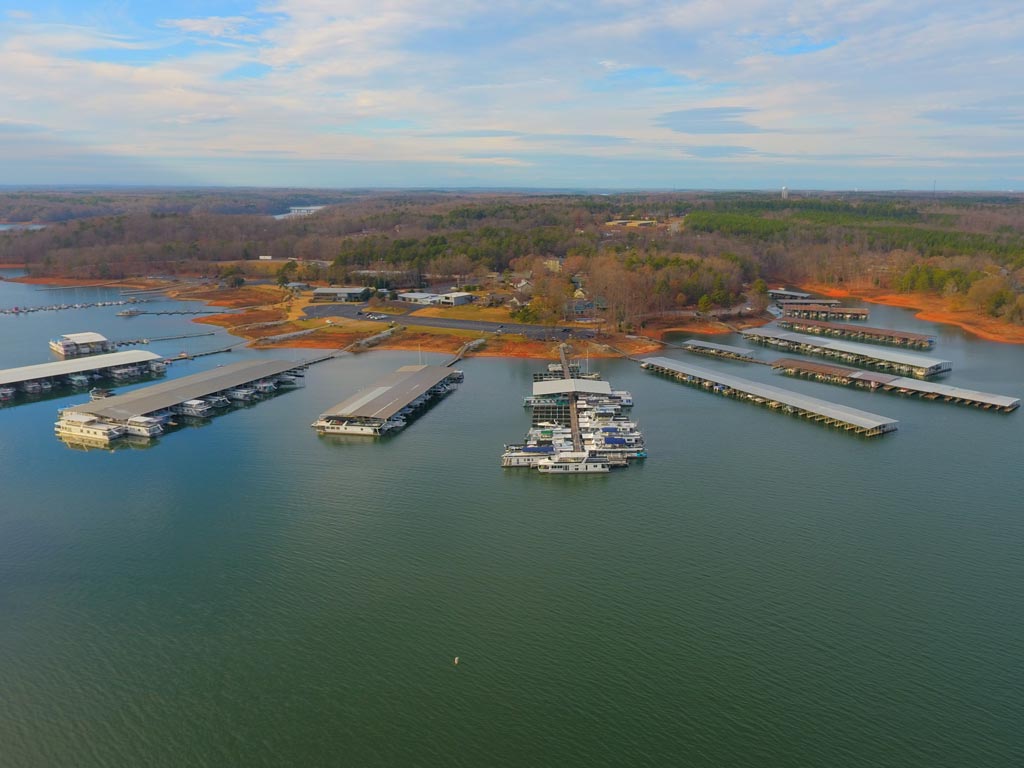
To top it all off, they’ll provide you with a boat you can use to navigate the lake. Not all spots are built the same, and sometimes you’ll need to switch between them to find the fish. Most of the time, your guide will also provide you with the rods, reels, and bait for your trip. This way, you’ll be able to focus on catching that prized fish and enjoying your time on the water.
Shore Fishing
If you feel fine with tackling Lake Hartwell on your own, setting up on one of the banks is definitely the more budget-friendly way to fish here. Sure, you might not get the same variety of spots, but it doesn’t mean you’ll go home skunked. And even if the worst happens and you don’t catch any fish, you’ll get to experience the surrounding nature and the lake’s breathtaking scenery.

But as we mentioned in the species section, many fish spend time in the shallow regions of the lake. This means it’s all about timing your trip right and working the coastal cover where the fish might be hiding. Depending on the time of year you visit Lake Hartwell, you can pretty much reel in all of its species from shore, although probably not in a single visit.
Kayak Fishing
Kayak fishing is becoming more and more popular among anglers, and for a good reason, too. When you’re on a lake, on a calm day, you can access all of its spots aboard a kayak. So if you already own one and you have experience fishing from it, it makes for both an economic way to fish on Lake Hartwell and a productive one.
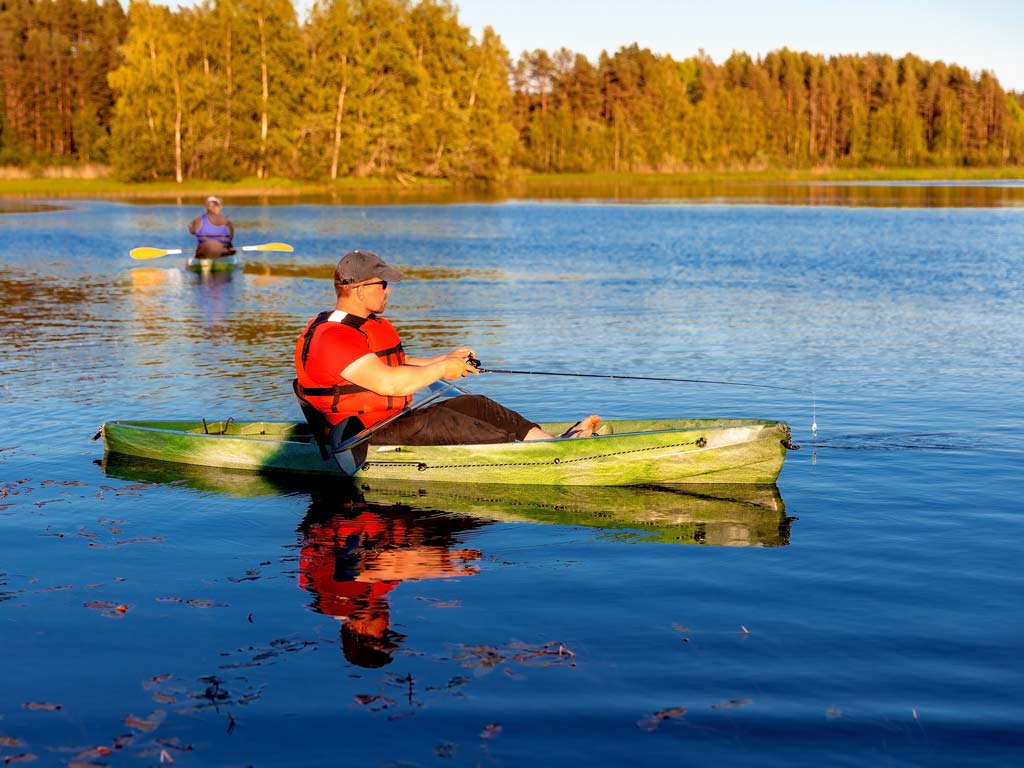
If you’re new to it, it may take time to master fishing from a kayak. But once you do so, you’ll have all of Lake Hartwell’s species at your fingertips. If you can’t transport your vessel to the lake, there are even companies that offer rental and delivery. Just keep an eye out for the weather, stay safe, and you’ll get to enjoy a unique experience on the lake.
Where is the best fishing in Lake Hartwell?

We can’t hope to name all the spots where you can reel in fish on Lake Hartwell. However, we’ll gladly go over some areas, so you know roughly where to try your luck. Of course, if you’re fishing with a guide, they’re the ones who’ll know how the fish are behaving at the time of your trip and lead you to where they are.
- Six and Twenty Creek: Located on the South Carolina portion of the lake, the Six and Twenty Creek is worth giving a shot whenever the fish are in the shallow. Bass, Crappie, and Catfish are all possible catches, and there are many other creeks nearby in case fish aren’t biting here.
- Beaverdam Creek: Located near the confluence of the Tugaloo and Seneca rivers, Beaverdam Creek is one of the most popular fishing options on the lake. It’s where anglers often head when trying to catch Largemouth and Spotted Bass, but other species may bite as well.
- Lightwood Log Creek: This creek lies northwest of Lake Hartwell Dam. Much like Beaverdam Creek, it’s one of the popular choices for Bass anglers. Fishing there, anglers often reel in Striped and Hybrid Bass, Largemouth, as well as all three species of Catfish.
- The Main Channel: Although it may seem like all the action is in the creeks, the main lake waters, below the Seneca-Tugaloo confluence are all the rage during summer. Search for spots around Andersonville Island and you could soon end up with Hybrids, Stripers, Catfish, or any other lake species taking your bait.
- Lake Hartwell Dam: Just under the dam, on the Georgian side of the Savannah River, there’s a recreational area along with a pier you can fish from. This spot in particular is great if you want to reel in Rainbow Trout, as they’re most commonly caught on this portion of the river.
Lake Hartwell Fishing FAQ
What kind of license do I need to fish in Lake Hartwell?
- Since the lake is situated on the border between Georgia and South Carolina, you can fish in its waters with either state’s license. All anglers aged 16 and older are required to buy fishing licenses.
Is it safe to eat fish caught in Lake Hartwell?
- There’s a fish consumption advisory in effect for Lake Hartwell. Most fish you catch should not be eaten, but it’s safe to eat one Channel Catfish, Spotted, or Largemouth Bass per month, according to the advisory.
Is Lake Hartwell fishing kids-friendly?
- Yes! Since the waters are generally calm, many guides offer family-friendly fishing trips on Lake Hartwell. They’ll take you to places with plenty of action and focus on fish even your young ones can reel in.
What fish regulations do I need to follow on Lake Hartwell?
- Most species that you’ll be targeting on Lake Hartwell have their own size and bag limits. These are often updated each season, so it’s best to check them out when you start planning your trip. You can get up-to-date information on Lake Hartwell fish regulations by visiting South Carolina’s Department of Natural Resources website.
Lake Hartwell: A World-Class Bass Fishing Lake

Blessed with enchanting nature and enough fish to satisfy even the most hardcore anglers, Lake Hartwell is one of the best fishing lakes you’ll find in this part of America. If it wasn’t on your bucket list up until now, add it on there. Then, the next time you’re planning a trip, consider pairing up with one of the lake’s guides, and you’ll be set for a world-class freshwater adventure.
Have you ever been fishing in Lake Hartwell? What’s your favorite area of the lake to explore? Let us know in the comments section below!
The post Fishing in Lake Hartwell: The Complete Guide appeared first on FishingBooker Blog.
https://ift.tt/SwCdM6g
0 Comments
Enregistrer un commentaire